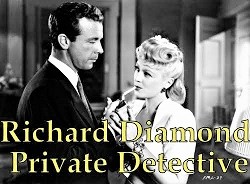
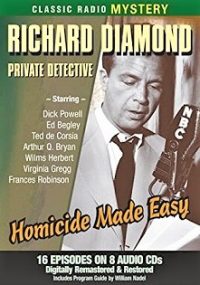 Richard Diamond, Private Detective (1949-52) aired “The Hollywood Story” first on November 16, 1951 as its 109th of some 141 original episodes, and then again on August 23, 1953 as a repeat and 153rd of its overall episodes. This is the repeat from 1953 and only the seventh Richard Diamond episode we’ve presented, the first being from early November of 2019 and the last just this past July of 2023. Due to the popularity of the earlier shows I thought it might be a good idea to offer Diamond fans with another, especially since this is only the 2nd episode since June of 2022. Therefore–-for newcomers to the show and those wishing to refresh their memories–-I reprise in slightly abbreviated form our earlier historical sketch of the program and its recurring characters.
Richard Diamond, Private Detective (1949-52) aired “The Hollywood Story” first on November 16, 1951 as its 109th of some 141 original episodes, and then again on August 23, 1953 as a repeat and 153rd of its overall episodes. This is the repeat from 1953 and only the seventh Richard Diamond episode we’ve presented, the first being from early November of 2019 and the last just this past July of 2023. Due to the popularity of the earlier shows I thought it might be a good idea to offer Diamond fans with another, especially since this is only the 2nd episode since June of 2022. Therefore–-for newcomers to the show and those wishing to refresh their memories–-I reprise in slightly abbreviated form our earlier historical sketch of the program and its recurring characters.
The show originally aired over NBC stations, then ABC, and then finally in 1953 by CBS, but all of the CBS shows were repeats from the 1950-51 season, thus some old time radio sites list the show’s run as going into 1953. Richard Diamond (starring film icon Dick Powell, 1904-1963) was an ex-cop turned private detective who maintained good relations with his ex-boss and police lieutenant Walter Levinson (played by Ed Begley [1901-1970], probably most well remembered as juror #10 in the classic 1957 film Twelve Angry Men, and father to actor Ed Begley, Jr.). Diamond’s girlfriend, Helen Asher, was played by Virginia Gregg (1916-1986, photo below with Powell), who went on to have many film and television roles (including the Twilight Zone episode “The Masks” which aired March 20, 1964). The character of Richard Diamond–-and the radio program itself–-was the brainchild of Blake Edwards (1922-2010), perhaps best known for writing and directing the Pink Panther movies, as well as directing other fine films such as Operation Petticoat (1959), Breakfast at Tiffany’s (1961), and Days of Wine and Roses (1962). Blake’s private detective Richard Diamond didn’t exactly fit the standard mold people were used to, as typified in the novels of Dashiell Hammett and Raymond Chandler. While he  could wisecrack with the best of them, he was also suave and sophisticated and tough as nails, living the high life in New York City when not found visiting the swank penthouse apartment of his girlfriend, Helen Asher. Being a well-seasoned song and dance man due to his many early movies where he inevitably ended up singing, Dick Powell was the perfect choice to play Richard Diamond, especially after his smashing success in 1944’s Murder, My Sweet. Audiences loved Powell as Diamond, so much so that the show’s popularity warranted its own television counterpart. It starred David Janssen (1931-1980) and ran from 1957-1960. Janssen, of course, is best remembered for his iconic role as Dr. Richard Kimble in the classic TV series The Fugitive (1963-67).
could wisecrack with the best of them, he was also suave and sophisticated and tough as nails, living the high life in New York City when not found visiting the swank penthouse apartment of his girlfriend, Helen Asher. Being a well-seasoned song and dance man due to his many early movies where he inevitably ended up singing, Dick Powell was the perfect choice to play Richard Diamond, especially after his smashing success in 1944’s Murder, My Sweet. Audiences loved Powell as Diamond, so much so that the show’s popularity warranted its own television counterpart. It starred David Janssen (1931-1980) and ran from 1957-1960. Janssen, of course, is best remembered for his iconic role as Dr. Richard Kimble in the classic TV series The Fugitive (1963-67).
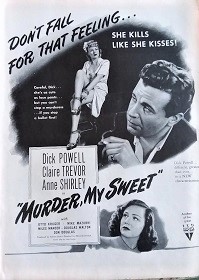 Dick Powell’s breakout film (briefly mentioned above) was 1944’s noir classic Murder, My Sweet. Based on Raymond Chandler’s detective character Philip Marlowe from his 1940 novel Farewell, My Lovely, the film was released with the book’s title but audience reaction was tepid at best, the feeling being that the title wasn’t dark enough and audiences assumed it was just another of Powell’s many light romances he had been making since the 1930s (30+ such roles from 1932-1939), in which he played handsome young men who wooed women with his boyish good looks, musical ability, and crooning voice. Getting older, and desirous of more mature roles that fit his middle aged demeanor, he convinced the powers that be to give him the role of Marlowe from Chandler’s novel. It was quite a gamble but Powell pulled it off admirably and the film is now recognized as a noir classic. When the film was released in late December of 1944 with the novel’s title and proved unsuccessful at the box office, it was quickly retitled Murder, My Sweet and re-released in February of 1945 in St. Louis with much better results. The box office and critical acclaim following the film led to several other noir films of note with Powell in the lead: Johnny O’Clock (1947, in which he played a detective), To the Ends of the Earth (1948, crime noir), and Pitfall (also 1948, film noir where he starred as a bored insurance agent who falls in love with the wrong woman).
Dick Powell’s breakout film (briefly mentioned above) was 1944’s noir classic Murder, My Sweet. Based on Raymond Chandler’s detective character Philip Marlowe from his 1940 novel Farewell, My Lovely, the film was released with the book’s title but audience reaction was tepid at best, the feeling being that the title wasn’t dark enough and audiences assumed it was just another of Powell’s many light romances he had been making since the 1930s (30+ such roles from 1932-1939), in which he played handsome young men who wooed women with his boyish good looks, musical ability, and crooning voice. Getting older, and desirous of more mature roles that fit his middle aged demeanor, he convinced the powers that be to give him the role of Marlowe from Chandler’s novel. It was quite a gamble but Powell pulled it off admirably and the film is now recognized as a noir classic. When the film was released in late December of 1944 with the novel’s title and proved unsuccessful at the box office, it was quickly retitled Murder, My Sweet and re-released in February of 1945 in St. Louis with much better results. The box office and critical acclaim following the film led to several other noir films of note with Powell in the lead: Johnny O’Clock (1947, in which he played a detective), To the Ends of the Earth (1948, crime noir), and Pitfall (also 1948, film noir where he starred as a bored insurance agent who falls in love with the wrong woman).
Powell was also active in television as actor, director, and producer. Arguably his best known TV endeavor was Dick Powell’s Zane Grey Theater or as it came to be known, simply Zane Grey Theatre (1956-1961). It was a western anthology series based on the works of Zane Grey, but as time went on new material was added to keep the stories fresh. It guest-starred many of the most well known or beloved and/or major TV/movie stars of the day, including but not limited to: Anne Bancroft, Robert Blake, Ernest Borgnine, Lloyd Bridges, Claudette Colbert, Hedy Lamarr, Julie London, Ginger Rogers, James Garner, Dennis Hopper, Burl Ives, Michael Landon, Edward G. Robinson, Jack Lemmon, David Niven, John Dehner, Burt Reynolds, Lon Chaney, Jr., Barbara Stanwyck, and many more. Much beloved in Hollywood and throughout the country by his legion of fans, Dick Powell died on February 3, 1963. His widow, well known actress June Allyson, gave his cause of death as lung cancer due to his chain smoking. Powell has a star on the Hollywood Walk of Fame.
This episode opens in the usual manner, with Diamond’s trademark whistling and a phone call. It turns out to be a call from a big mucky-muck in Hollywood who wants our private dick to get him out of a jam, a jam all too common when a married man of wealth and means gets blackmailed by a beautiful blonde from Las Vegas, and blackmailed for an extremely large sum of money. But why is this Hollywood big wig not seeking help from a local private detective instead of from an outsider, and is this seemingly routine case as straightforward as it might appear? The answers to both questions are revealed only by listening to this scheme-heavy storyline which, of course, takes a sideways turn into murder.
[Left: Murder, My Sweet poster – Right: Virginia Gregg & Dick Powell]
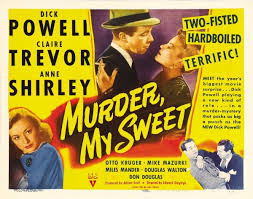
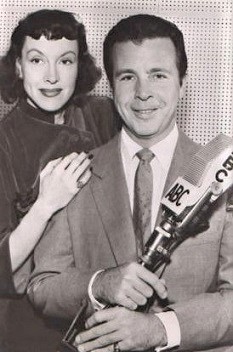
(The linked CD at top of page includes this episode and 15 others.)
Play Time: 30.25
{This episode aired on a Sunday evening in mid-August of 1953, and though a detective mystery the neighborhood gang couldn’t wait to gather at the corner newsstand after school the next afternoon to find some of their favorite reading in another genre. If, Worlds of Science Fiction (1952-74) was a new magazine the gang had eagerly bought shortly after its debut issue, and it’s easy to see why if this issue was any indication. It featured one of James Blish’s now classic novels A Case of Conscience, first novelized in book form in 1958 as the first of his After Such Knowledge trilogy, the other volumes being Doctor Mirabilis, and the pair of novellas forming the third volume of the trilogy, Black Easter and The Day After Judgment. All are highly recommended and justly considered classics. If was a bi-monthly in 1953. Thrilling Wonder Stories (1936-55) was a longtime favorite with its colorful escapades on other worlds, where evil of all kinds abounded and scantily-clad women were always needing saving by the hero. Many a favorite author saw their stories published here, and a fair number of these wild adventures have gone on to become today’s classics, reprinted in many a themed collection over the years. TWS was a bi-monthly in 1953. Weird Tales (1923-54) was the premier be all and end all of supernatural horror magazines for many a decade. It featured on a regular basis most of the giants in the horror field writing at the top of their form. It became justly known as “the unique magazine” and many of the magazine’s issues–if they can be found–command top dollar at science fiction convention dealer rooms. It, too, was a bi-monthly in 1953.}
[Left: If, 9/53 – Center: Thrilling Wonder Stories, 8/53 – Right: Weird Tales, 9/53]
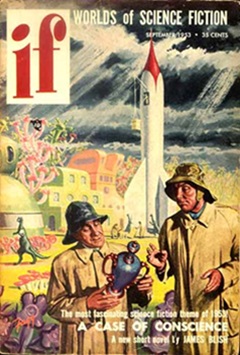
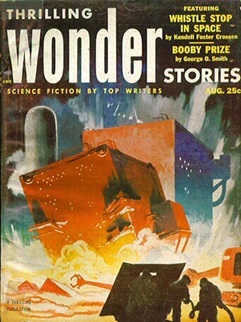
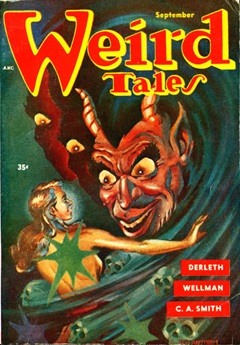
To view the entire list of weekly Old Time Radio episodes at Tangent Online, click here.